Business Strategy Report: Analyzing Vodafone's Competitive Position
VerifiedAdded on 2020/07/22
|14
|4555
|66
Report
AI Summary
This report provides a comprehensive analysis of Vodafone's business strategy, examining the impact of the external environment through a PESTLE analysis, which considers political, economic, social, technological, legal, and environmental factors. It then delves into Vodafone's strategic capabilities, defining them and applying the VRIN model (Value, Rareness, Imitability, Non-substitutability) to assess its competitive advantages. The report also evaluates Vodafone's strengths and weaknesses, and assesses its competitiveness. Furthermore, it explores the Ansoff matrix to analyze strategic options like market penetration, product development, market development, and diversification. Finally, the report discusses strategic directions and available options for the company, providing a detailed understanding of Vodafone's position in the telecommunications market.
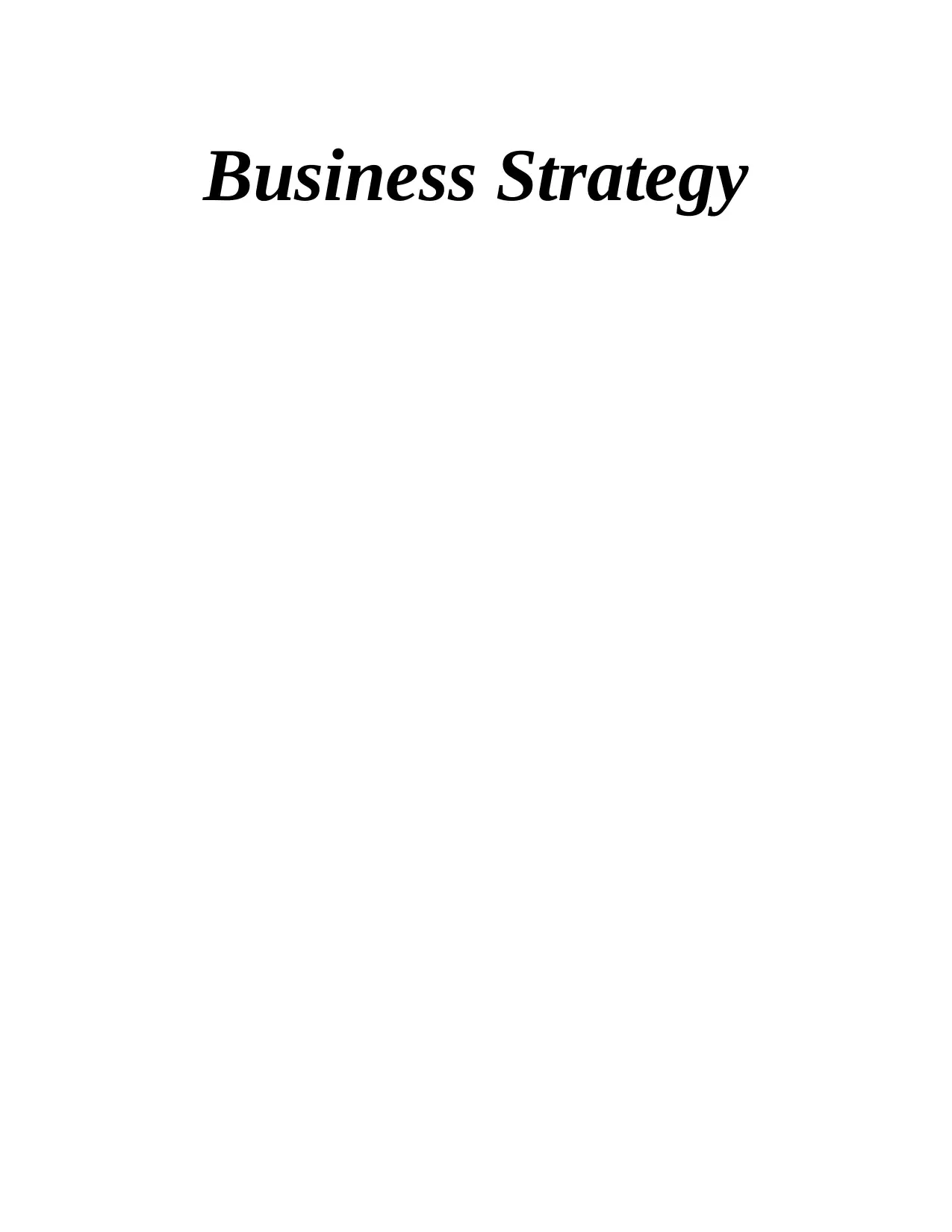
Business Strategy
Paraphrase This Document
Need a fresh take? Get an instant paraphrase of this document with our AI Paraphraser
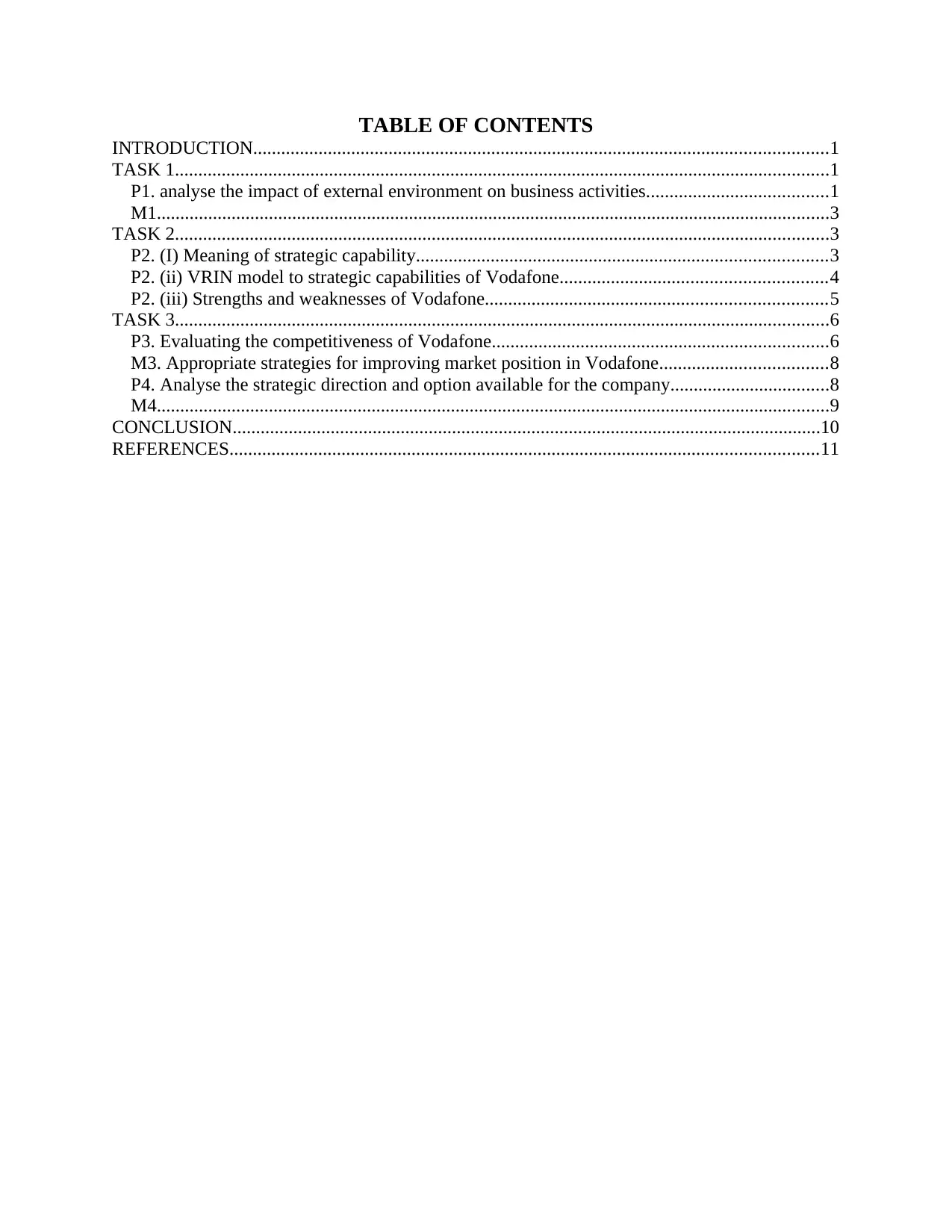
TABLE OF CONTENTS
INTRODUCTION...........................................................................................................................1
TASK 1............................................................................................................................................1
P1. analyse the impact of external environment on business activities.......................................1
M1................................................................................................................................................3
TASK 2............................................................................................................................................3
P2. (I) Meaning of strategic capability........................................................................................3
P2. (ii) VRIN model to strategic capabilities of Vodafone.........................................................4
P2. (iii) Strengths and weaknesses of Vodafone.........................................................................5
TASK 3............................................................................................................................................6
P3. Evaluating the competitiveness of Vodafone........................................................................6
M3. Appropriate strategies for improving market position in Vodafone....................................8
P4. Analyse the strategic direction and option available for the company..................................8
M4................................................................................................................................................9
CONCLUSION..............................................................................................................................10
REFERENCES..............................................................................................................................11
INTRODUCTION...........................................................................................................................1
TASK 1............................................................................................................................................1
P1. analyse the impact of external environment on business activities.......................................1
M1................................................................................................................................................3
TASK 2............................................................................................................................................3
P2. (I) Meaning of strategic capability........................................................................................3
P2. (ii) VRIN model to strategic capabilities of Vodafone.........................................................4
P2. (iii) Strengths and weaknesses of Vodafone.........................................................................5
TASK 3............................................................................................................................................6
P3. Evaluating the competitiveness of Vodafone........................................................................6
M3. Appropriate strategies for improving market position in Vodafone....................................8
P4. Analyse the strategic direction and option available for the company..................................8
M4................................................................................................................................................9
CONCLUSION..............................................................................................................................10
REFERENCES..............................................................................................................................11
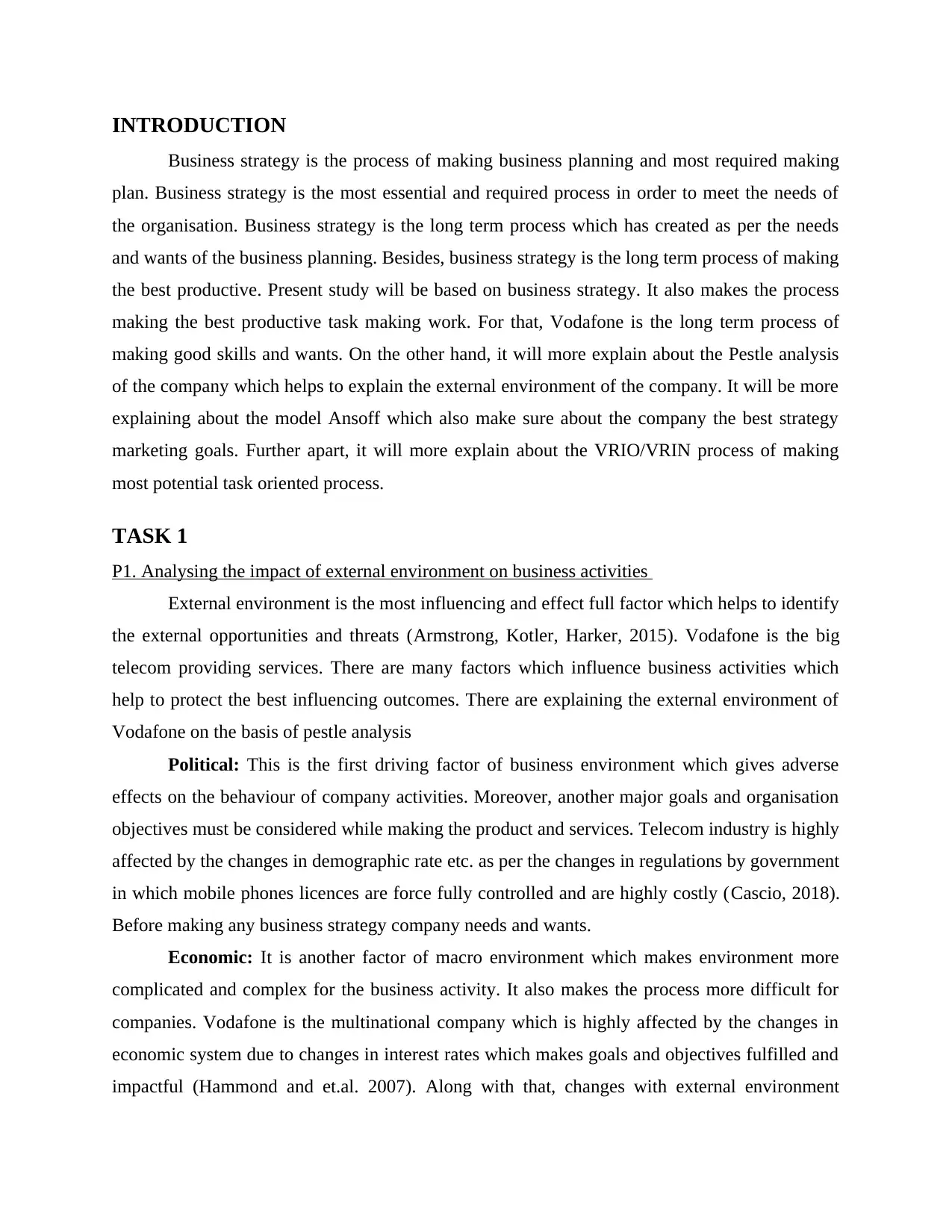
INTRODUCTION
Business strategy is the process of making business planning and most required making
plan. Business strategy is the most essential and required process in order to meet the needs of
the organisation. Business strategy is the long term process which has created as per the needs
and wants of the business planning. Besides, business strategy is the long term process of making
the best productive. Present study will be based on business strategy. It also makes the process
making the best productive task making work. For that, Vodafone is the long term process of
making good skills and wants. On the other hand, it will more explain about the Pestle analysis
of the company which helps to explain the external environment of the company. It will be more
explaining about the model Ansoff which also make sure about the company the best strategy
marketing goals. Further apart, it will more explain about the VRIO/VRIN process of making
most potential task oriented process.
TASK 1
P1. Analysing the impact of external environment on business activities
External environment is the most influencing and effect full factor which helps to identify
the external opportunities and threats (Armstrong, Kotler, Harker, 2015). Vodafone is the big
telecom providing services. There are many factors which influence business activities which
help to protect the best influencing outcomes. There are explaining the external environment of
Vodafone on the basis of pestle analysis
Political: This is the first driving factor of business environment which gives adverse
effects on the behaviour of company activities. Moreover, another major goals and organisation
objectives must be considered while making the product and services. Telecom industry is highly
affected by the changes in demographic rate etc. as per the changes in regulations by government
in which mobile phones licences are force fully controlled and are highly costly (Cascio, 2018).
Before making any business strategy company needs and wants.
Economic: It is another factor of macro environment which makes environment more
complicated and complex for the business activity. It also makes the process more difficult for
companies. Vodafone is the multinational company which is highly affected by the changes in
economic system due to changes in interest rates which makes goals and objectives fulfilled and
impactful (Hammond and et.al. 2007). Along with that, changes with external environment
Business strategy is the process of making business planning and most required making
plan. Business strategy is the most essential and required process in order to meet the needs of
the organisation. Business strategy is the long term process which has created as per the needs
and wants of the business planning. Besides, business strategy is the long term process of making
the best productive. Present study will be based on business strategy. It also makes the process
making the best productive task making work. For that, Vodafone is the long term process of
making good skills and wants. On the other hand, it will more explain about the Pestle analysis
of the company which helps to explain the external environment of the company. It will be more
explaining about the model Ansoff which also make sure about the company the best strategy
marketing goals. Further apart, it will more explain about the VRIO/VRIN process of making
most potential task oriented process.
TASK 1
P1. Analysing the impact of external environment on business activities
External environment is the most influencing and effect full factor which helps to identify
the external opportunities and threats (Armstrong, Kotler, Harker, 2015). Vodafone is the big
telecom providing services. There are many factors which influence business activities which
help to protect the best influencing outcomes. There are explaining the external environment of
Vodafone on the basis of pestle analysis
Political: This is the first driving factor of business environment which gives adverse
effects on the behaviour of company activities. Moreover, another major goals and organisation
objectives must be considered while making the product and services. Telecom industry is highly
affected by the changes in demographic rate etc. as per the changes in regulations by government
in which mobile phones licences are force fully controlled and are highly costly (Cascio, 2018).
Before making any business strategy company needs and wants.
Economic: It is another factor of macro environment which makes environment more
complicated and complex for the business activity. It also makes the process more difficult for
companies. Vodafone is the multinational company which is highly affected by the changes in
economic system due to changes in interest rates which makes goals and objectives fulfilled and
impactful (Hammond and et.al. 2007). Along with that, changes with external environment
⊘ This is a preview!⊘
Do you want full access?
Subscribe today to unlock all pages.

Trusted by 1+ million students worldwide
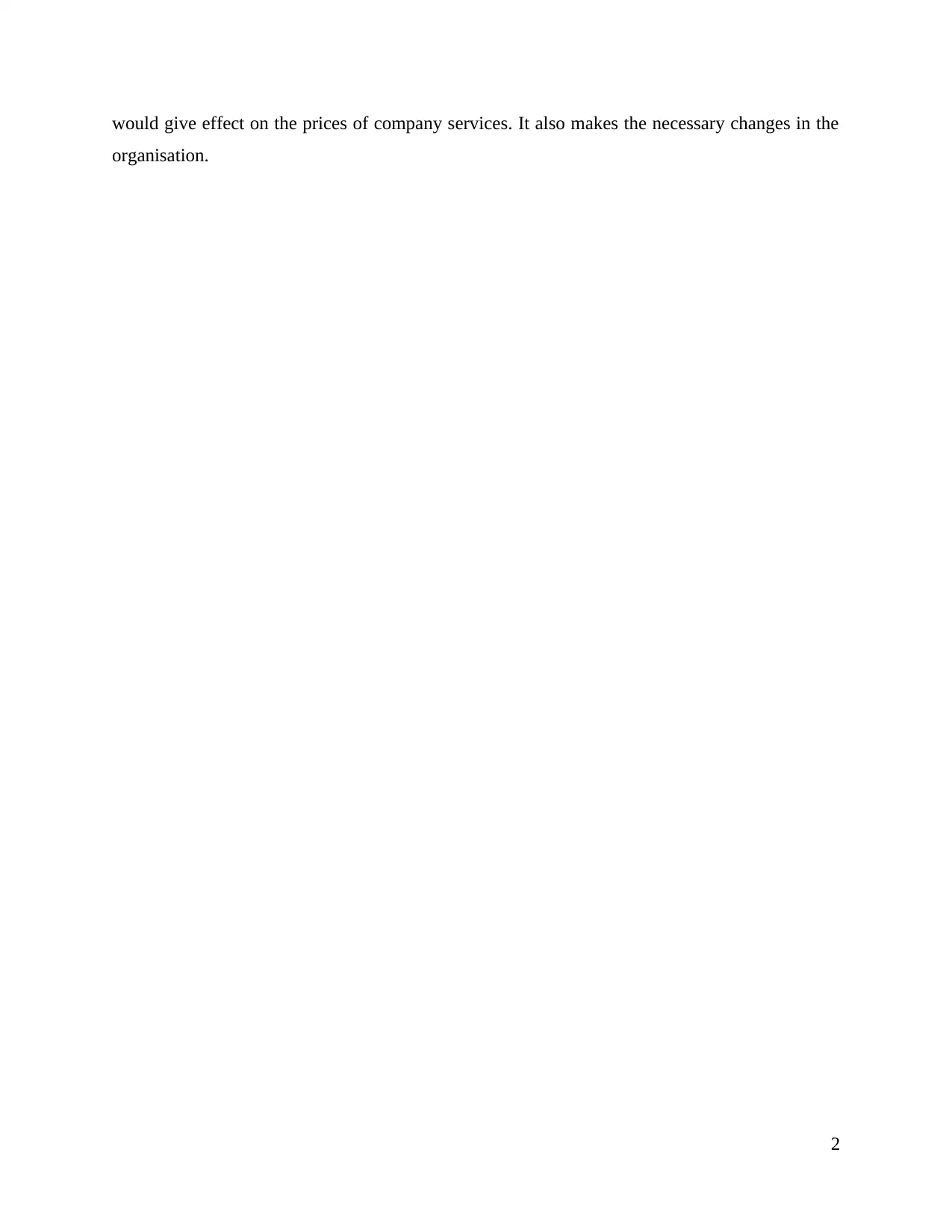
would give effect on the prices of company services. It also makes the necessary changes in the
organisation.
2
organisation.
2
Paraphrase This Document
Need a fresh take? Get an instant paraphrase of this document with our AI Paraphraser
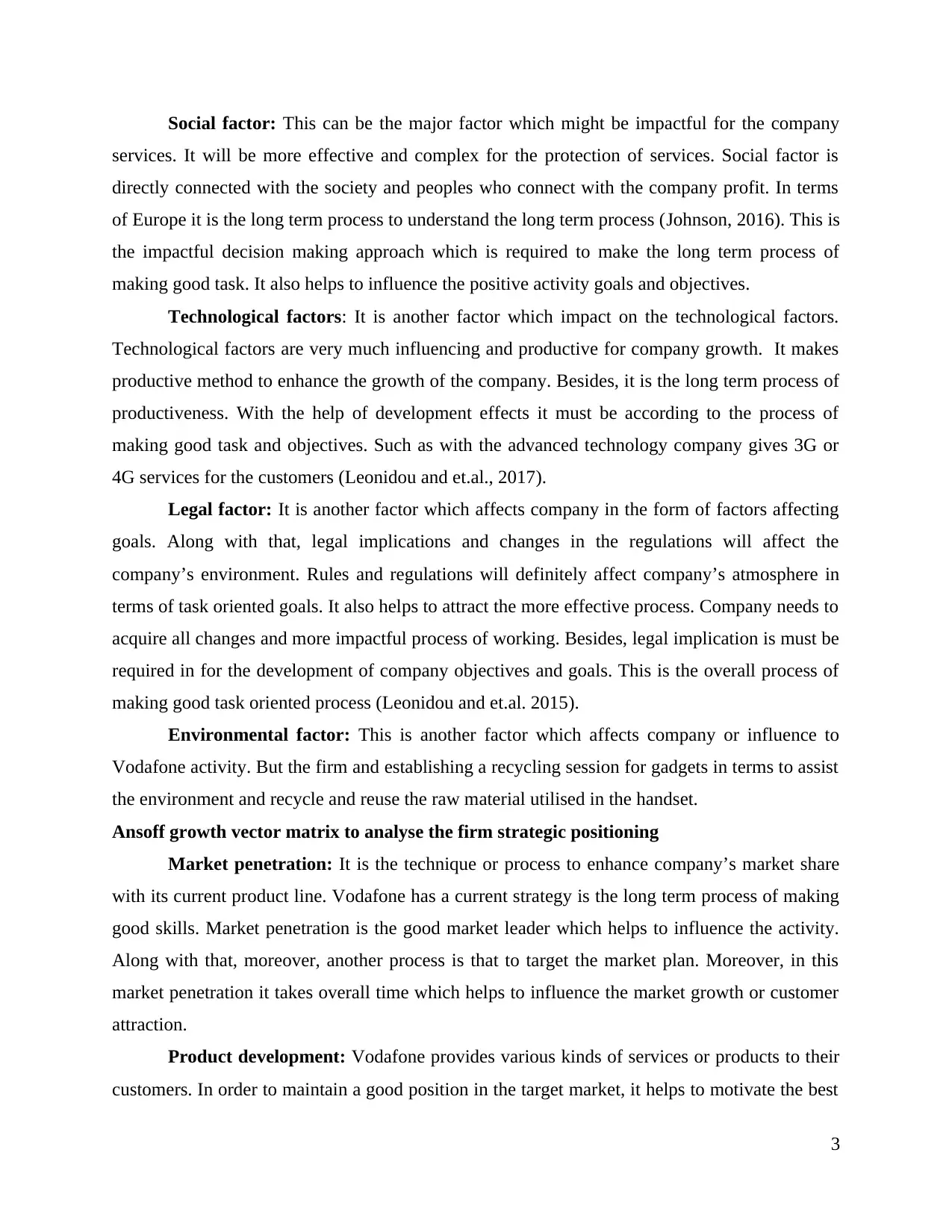
Social factor: This can be the major factor which might be impactful for the company
services. It will be more effective and complex for the protection of services. Social factor is
directly connected with the society and peoples who connect with the company profit. In terms
of Europe it is the long term process to understand the long term process (Johnson, 2016). This is
the impactful decision making approach which is required to make the long term process of
making good task. It also helps to influence the positive activity goals and objectives.
Technological factors: It is another factor which impact on the technological factors.
Technological factors are very much influencing and productive for company growth. It makes
productive method to enhance the growth of the company. Besides, it is the long term process of
productiveness. With the help of development effects it must be according to the process of
making good task and objectives. Such as with the advanced technology company gives 3G or
4G services for the customers (Leonidou and et.al., 2017).
Legal factor: It is another factor which affects company in the form of factors affecting
goals. Along with that, legal implications and changes in the regulations will affect the
company’s environment. Rules and regulations will definitely affect company’s atmosphere in
terms of task oriented goals. It also helps to attract the more effective process. Company needs to
acquire all changes and more impactful process of working. Besides, legal implication is must be
required in for the development of company objectives and goals. This is the overall process of
making good task oriented process (Leonidou and et.al. 2015).
Environmental factor: This is another factor which affects company or influence to
Vodafone activity. But the firm and establishing a recycling session for gadgets in terms to assist
the environment and recycle and reuse the raw material utilised in the handset.
Ansoff growth vector matrix to analyse the firm strategic positioning
Market penetration: It is the technique or process to enhance company’s market share
with its current product line. Vodafone has a current strategy is the long term process of making
good skills. Market penetration is the good market leader which helps to influence the activity.
Along with that, moreover, another process is that to target the market plan. Moreover, in this
market penetration it takes overall time which helps to influence the market growth or customer
attraction.
Product development: Vodafone provides various kinds of services or products to their
customers. In order to maintain a good position in the target market, it helps to motivate the best
3
services. It will be more effective and complex for the protection of services. Social factor is
directly connected with the society and peoples who connect with the company profit. In terms
of Europe it is the long term process to understand the long term process (Johnson, 2016). This is
the impactful decision making approach which is required to make the long term process of
making good task. It also helps to influence the positive activity goals and objectives.
Technological factors: It is another factor which impact on the technological factors.
Technological factors are very much influencing and productive for company growth. It makes
productive method to enhance the growth of the company. Besides, it is the long term process of
productiveness. With the help of development effects it must be according to the process of
making good task and objectives. Such as with the advanced technology company gives 3G or
4G services for the customers (Leonidou and et.al., 2017).
Legal factor: It is another factor which affects company in the form of factors affecting
goals. Along with that, legal implications and changes in the regulations will affect the
company’s environment. Rules and regulations will definitely affect company’s atmosphere in
terms of task oriented goals. It also helps to attract the more effective process. Company needs to
acquire all changes and more impactful process of working. Besides, legal implication is must be
required in for the development of company objectives and goals. This is the overall process of
making good task oriented process (Leonidou and et.al. 2015).
Environmental factor: This is another factor which affects company or influence to
Vodafone activity. But the firm and establishing a recycling session for gadgets in terms to assist
the environment and recycle and reuse the raw material utilised in the handset.
Ansoff growth vector matrix to analyse the firm strategic positioning
Market penetration: It is the technique or process to enhance company’s market share
with its current product line. Vodafone has a current strategy is the long term process of making
good skills. Market penetration is the good market leader which helps to influence the activity.
Along with that, moreover, another process is that to target the market plan. Moreover, in this
market penetration it takes overall time which helps to influence the market growth or customer
attraction.
Product development: Vodafone provides various kinds of services or products to their
customers. In order to maintain a good position in the target market, it helps to motivate the best
3
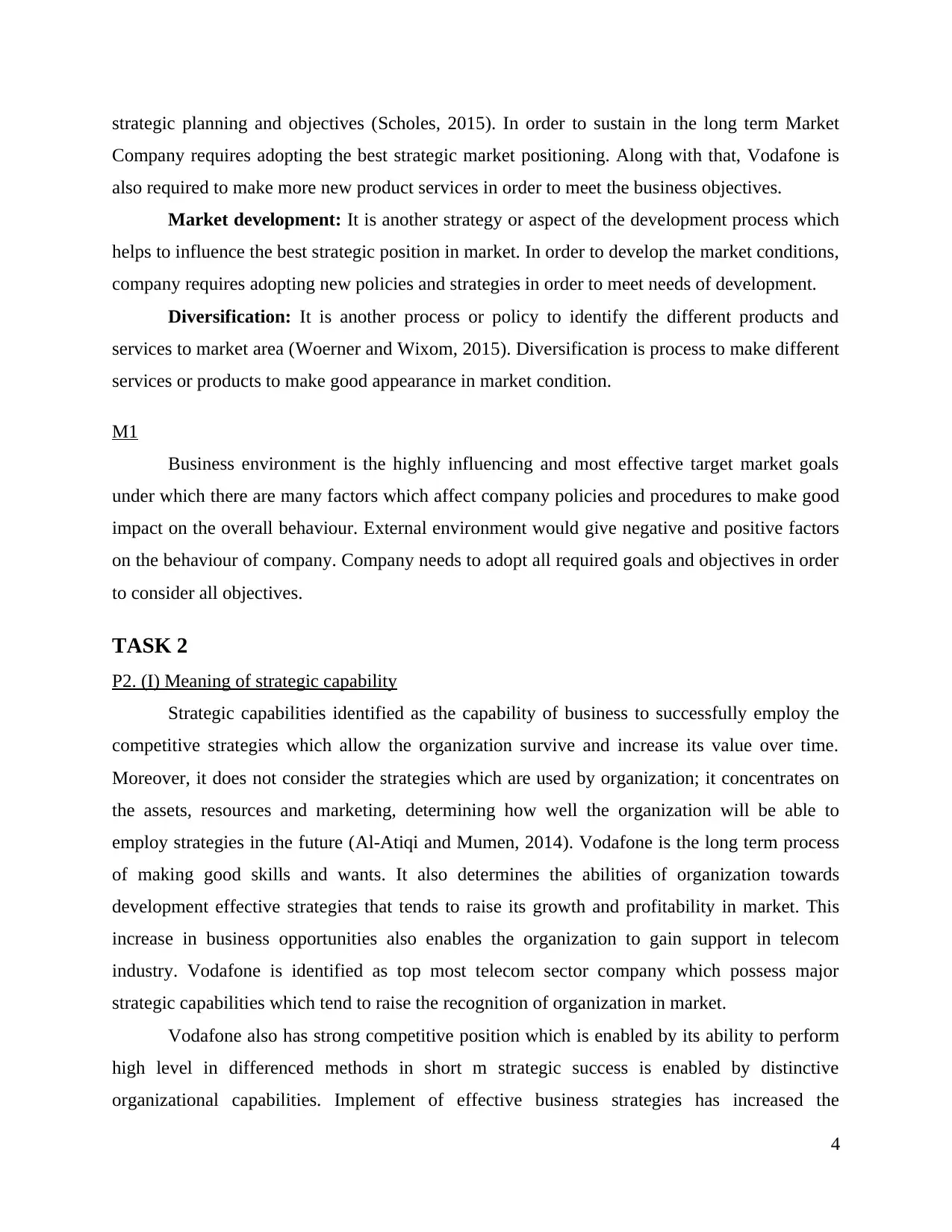
strategic planning and objectives (Scholes, 2015). In order to sustain in the long term Market
Company requires adopting the best strategic market positioning. Along with that, Vodafone is
also required to make more new product services in order to meet the business objectives.
Market development: It is another strategy or aspect of the development process which
helps to influence the best strategic position in market. In order to develop the market conditions,
company requires adopting new policies and strategies in order to meet needs of development.
Diversification: It is another process or policy to identify the different products and
services to market area (Woerner and Wixom, 2015). Diversification is process to make different
services or products to make good appearance in market condition.
M1
Business environment is the highly influencing and most effective target market goals
under which there are many factors which affect company policies and procedures to make good
impact on the overall behaviour. External environment would give negative and positive factors
on the behaviour of company. Company needs to adopt all required goals and objectives in order
to consider all objectives.
TASK 2
P2. (I) Meaning of strategic capability
Strategic capabilities identified as the capability of business to successfully employ the
competitive strategies which allow the organization survive and increase its value over time.
Moreover, it does not consider the strategies which are used by organization; it concentrates on
the assets, resources and marketing, determining how well the organization will be able to
employ strategies in the future (Al-Atiqi and Mumen, 2014). Vodafone is the long term process
of making good skills and wants. It also determines the abilities of organization towards
development effective strategies that tends to raise its growth and profitability in market. This
increase in business opportunities also enables the organization to gain support in telecom
industry. Vodafone is identified as top most telecom sector company which possess major
strategic capabilities which tend to raise the recognition of organization in market.
Vodafone also has strong competitive position which is enabled by its ability to perform
high level in differenced methods in short m strategic success is enabled by distinctive
organizational capabilities. Implement of effective business strategies has increased the
4
Company requires adopting the best strategic market positioning. Along with that, Vodafone is
also required to make more new product services in order to meet the business objectives.
Market development: It is another strategy or aspect of the development process which
helps to influence the best strategic position in market. In order to develop the market conditions,
company requires adopting new policies and strategies in order to meet needs of development.
Diversification: It is another process or policy to identify the different products and
services to market area (Woerner and Wixom, 2015). Diversification is process to make different
services or products to make good appearance in market condition.
M1
Business environment is the highly influencing and most effective target market goals
under which there are many factors which affect company policies and procedures to make good
impact on the overall behaviour. External environment would give negative and positive factors
on the behaviour of company. Company needs to adopt all required goals and objectives in order
to consider all objectives.
TASK 2
P2. (I) Meaning of strategic capability
Strategic capabilities identified as the capability of business to successfully employ the
competitive strategies which allow the organization survive and increase its value over time.
Moreover, it does not consider the strategies which are used by organization; it concentrates on
the assets, resources and marketing, determining how well the organization will be able to
employ strategies in the future (Al-Atiqi and Mumen, 2014). Vodafone is the long term process
of making good skills and wants. It also determines the abilities of organization towards
development effective strategies that tends to raise its growth and profitability in market. This
increase in business opportunities also enables the organization to gain support in telecom
industry. Vodafone is identified as top most telecom sector company which possess major
strategic capabilities which tend to raise the recognition of organization in market.
Vodafone also has strong competitive position which is enabled by its ability to perform
high level in differenced methods in short m strategic success is enabled by distinctive
organizational capabilities. Implement of effective business strategies has increased the
4
⊘ This is a preview!⊘
Do you want full access?
Subscribe today to unlock all pages.

Trusted by 1+ million students worldwide
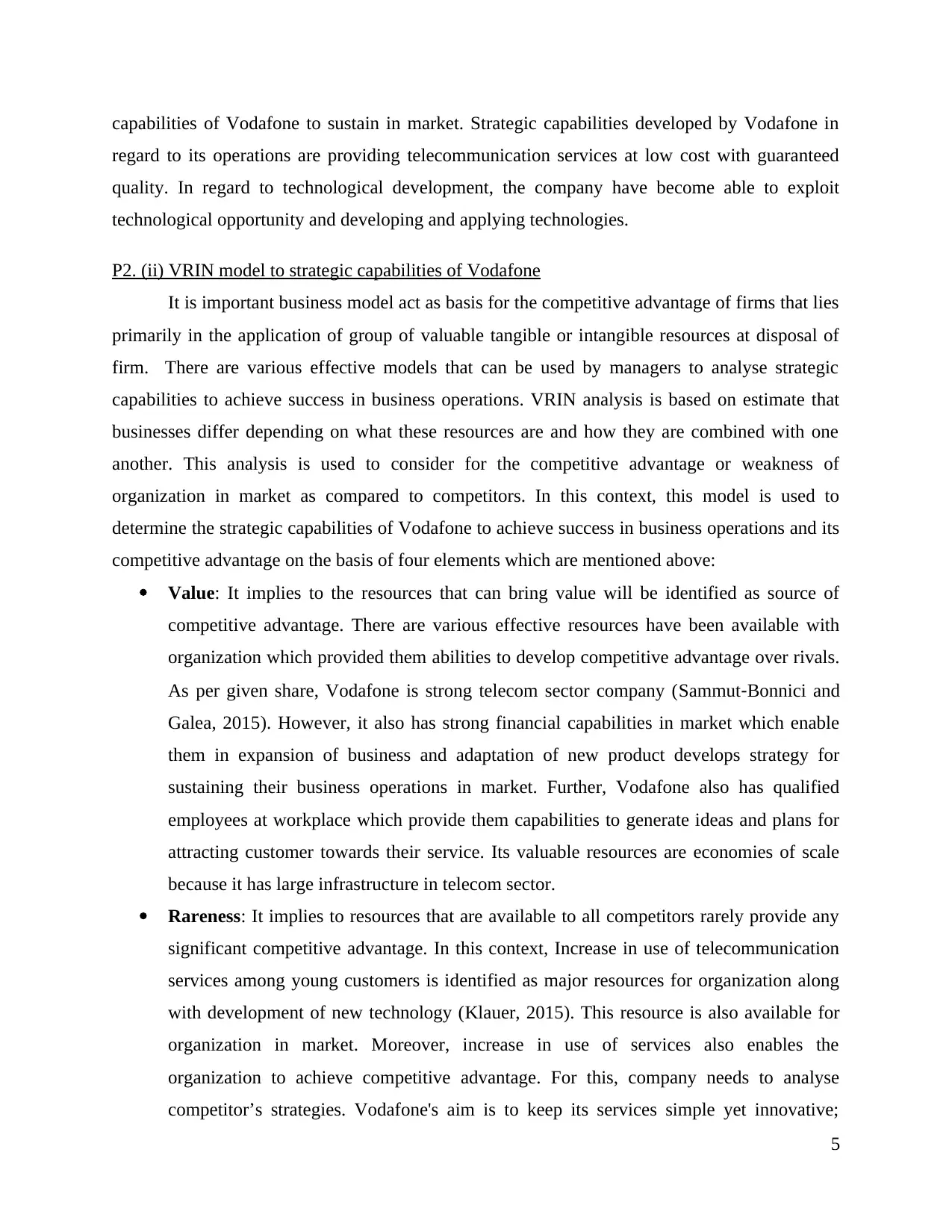
capabilities of Vodafone to sustain in market. Strategic capabilities developed by Vodafone in
regard to its operations are providing telecommunication services at low cost with guaranteed
quality. In regard to technological development, the company have become able to exploit
technological opportunity and developing and applying technologies.
P2. (ii) VRIN model to strategic capabilities of Vodafone
It is important business model act as basis for the competitive advantage of firms that lies
primarily in the application of group of valuable tangible or intangible resources at disposal of
firm. There are various effective models that can be used by managers to analyse strategic
capabilities to achieve success in business operations. VRIN analysis is based on estimate that
businesses differ depending on what these resources are and how they are combined with one
another. This analysis is used to consider for the competitive advantage or weakness of
organization in market as compared to competitors. In this context, this model is used to
determine the strategic capabilities of Vodafone to achieve success in business operations and its
competitive advantage on the basis of four elements which are mentioned above:
Value: It implies to the resources that can bring value will be identified as source of
competitive advantage. There are various effective resources have been available with
organization which provided them abilities to develop competitive advantage over rivals.
As per given share, Vodafone is strong telecom sector company (Sammut‐Bonnici and
Galea, 2015). However, it also has strong financial capabilities in market which enable
them in expansion of business and adaptation of new product develops strategy for
sustaining their business operations in market. Further, Vodafone also has qualified
employees at workplace which provide them capabilities to generate ideas and plans for
attracting customer towards their service. Its valuable resources are economies of scale
because it has large infrastructure in telecom sector.
Rareness: It implies to resources that are available to all competitors rarely provide any
significant competitive advantage. In this context, Increase in use of telecommunication
services among young customers is identified as major resources for organization along
with development of new technology (Klauer, 2015). This resource is also available for
organization in market. Moreover, increase in use of services also enables the
organization to achieve competitive advantage. For this, company needs to analyse
competitor’s strategies. Vodafone's aim is to keep its services simple yet innovative;
5
regard to its operations are providing telecommunication services at low cost with guaranteed
quality. In regard to technological development, the company have become able to exploit
technological opportunity and developing and applying technologies.
P2. (ii) VRIN model to strategic capabilities of Vodafone
It is important business model act as basis for the competitive advantage of firms that lies
primarily in the application of group of valuable tangible or intangible resources at disposal of
firm. There are various effective models that can be used by managers to analyse strategic
capabilities to achieve success in business operations. VRIN analysis is based on estimate that
businesses differ depending on what these resources are and how they are combined with one
another. This analysis is used to consider for the competitive advantage or weakness of
organization in market as compared to competitors. In this context, this model is used to
determine the strategic capabilities of Vodafone to achieve success in business operations and its
competitive advantage on the basis of four elements which are mentioned above:
Value: It implies to the resources that can bring value will be identified as source of
competitive advantage. There are various effective resources have been available with
organization which provided them abilities to develop competitive advantage over rivals.
As per given share, Vodafone is strong telecom sector company (Sammut‐Bonnici and
Galea, 2015). However, it also has strong financial capabilities in market which enable
them in expansion of business and adaptation of new product develops strategy for
sustaining their business operations in market. Further, Vodafone also has qualified
employees at workplace which provide them capabilities to generate ideas and plans for
attracting customer towards their service. Its valuable resources are economies of scale
because it has large infrastructure in telecom sector.
Rareness: It implies to resources that are available to all competitors rarely provide any
significant competitive advantage. In this context, Increase in use of telecommunication
services among young customers is identified as major resources for organization along
with development of new technology (Klauer, 2015). This resource is also available for
organization in market. Moreover, increase in use of services also enables the
organization to achieve competitive advantage. For this, company needs to analyse
competitor’s strategies. Vodafone's aim is to keep its services simple yet innovative;
5
Paraphrase This Document
Need a fresh take? Get an instant paraphrase of this document with our AI Paraphraser
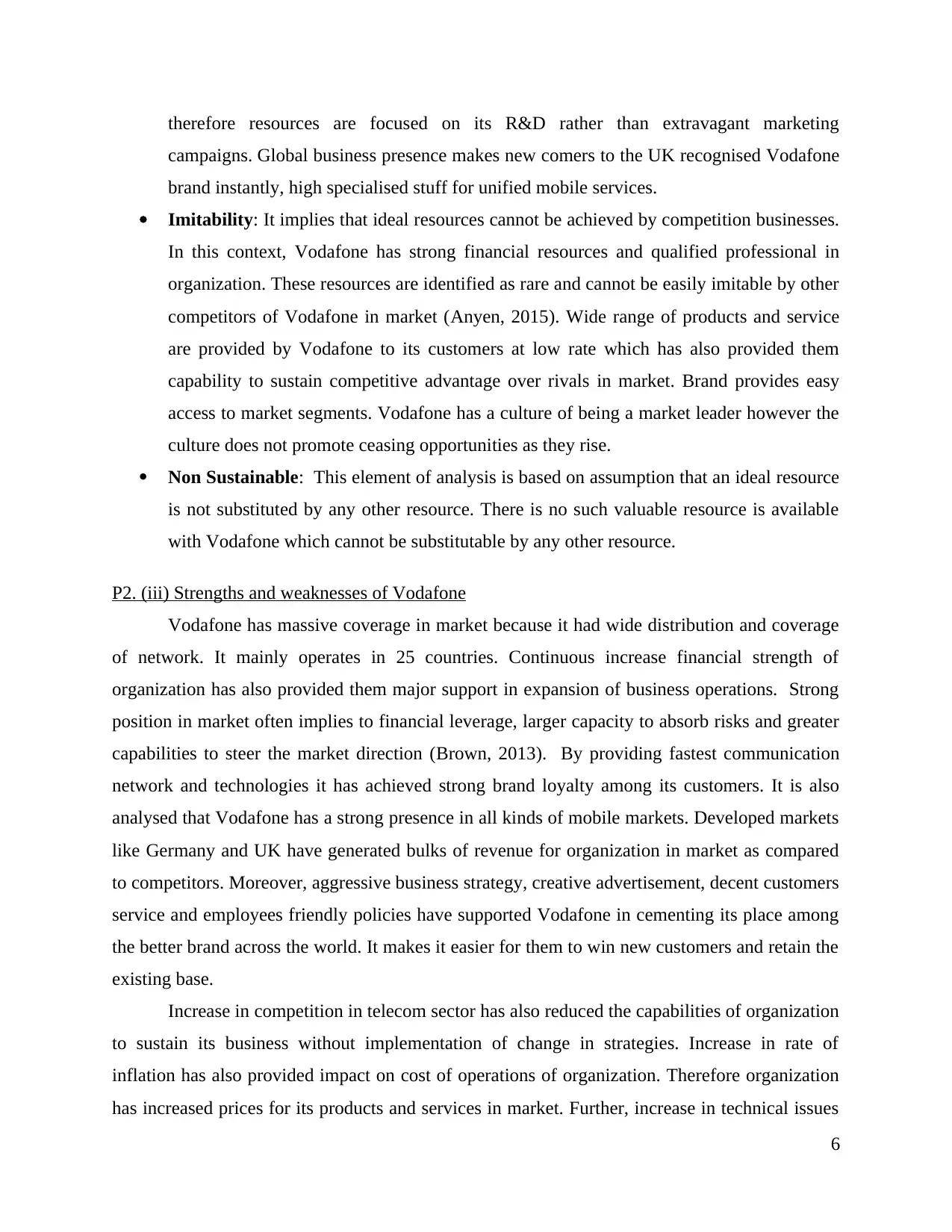
therefore resources are focused on its R&D rather than extravagant marketing
campaigns. Global business presence makes new comers to the UK recognised Vodafone
brand instantly, high specialised stuff for unified mobile services.
Imitability: It implies that ideal resources cannot be achieved by competition businesses.
In this context, Vodafone has strong financial resources and qualified professional in
organization. These resources are identified as rare and cannot be easily imitable by other
competitors of Vodafone in market (Anyen, 2015). Wide range of products and service
are provided by Vodafone to its customers at low rate which has also provided them
capability to sustain competitive advantage over rivals in market. Brand provides easy
access to market segments. Vodafone has a culture of being a market leader however the
culture does not promote ceasing opportunities as they rise.
Non Sustainable: This element of analysis is based on assumption that an ideal resource
is not substituted by any other resource. There is no such valuable resource is available
with Vodafone which cannot be substitutable by any other resource.
P2. (iii) Strengths and weaknesses of Vodafone
Vodafone has massive coverage in market because it had wide distribution and coverage
of network. It mainly operates in 25 countries. Continuous increase financial strength of
organization has also provided them major support in expansion of business operations. Strong
position in market often implies to financial leverage, larger capacity to absorb risks and greater
capabilities to steer the market direction (Brown, 2013). By providing fastest communication
network and technologies it has achieved strong brand loyalty among its customers. It is also
analysed that Vodafone has a strong presence in all kinds of mobile markets. Developed markets
like Germany and UK have generated bulks of revenue for organization in market as compared
to competitors. Moreover, aggressive business strategy, creative advertisement, decent customers
service and employees friendly policies have supported Vodafone in cementing its place among
the better brand across the world. It makes it easier for them to win new customers and retain the
existing base.
Increase in competition in telecom sector has also reduced the capabilities of organization
to sustain its business without implementation of change in strategies. Increase in rate of
inflation has also provided impact on cost of operations of organization. Therefore organization
has increased prices for its products and services in market. Further, increase in technical issues
6
campaigns. Global business presence makes new comers to the UK recognised Vodafone
brand instantly, high specialised stuff for unified mobile services.
Imitability: It implies that ideal resources cannot be achieved by competition businesses.
In this context, Vodafone has strong financial resources and qualified professional in
organization. These resources are identified as rare and cannot be easily imitable by other
competitors of Vodafone in market (Anyen, 2015). Wide range of products and service
are provided by Vodafone to its customers at low rate which has also provided them
capability to sustain competitive advantage over rivals in market. Brand provides easy
access to market segments. Vodafone has a culture of being a market leader however the
culture does not promote ceasing opportunities as they rise.
Non Sustainable: This element of analysis is based on assumption that an ideal resource
is not substituted by any other resource. There is no such valuable resource is available
with Vodafone which cannot be substitutable by any other resource.
P2. (iii) Strengths and weaknesses of Vodafone
Vodafone has massive coverage in market because it had wide distribution and coverage
of network. It mainly operates in 25 countries. Continuous increase financial strength of
organization has also provided them major support in expansion of business operations. Strong
position in market often implies to financial leverage, larger capacity to absorb risks and greater
capabilities to steer the market direction (Brown, 2013). By providing fastest communication
network and technologies it has achieved strong brand loyalty among its customers. It is also
analysed that Vodafone has a strong presence in all kinds of mobile markets. Developed markets
like Germany and UK have generated bulks of revenue for organization in market as compared
to competitors. Moreover, aggressive business strategy, creative advertisement, decent customers
service and employees friendly policies have supported Vodafone in cementing its place among
the better brand across the world. It makes it easier for them to win new customers and retain the
existing base.
Increase in competition in telecom sector has also reduced the capabilities of organization
to sustain its business without implementation of change in strategies. Increase in rate of
inflation has also provided impact on cost of operations of organization. Therefore organization
has increased prices for its products and services in market. Further, increase in technical issues
6
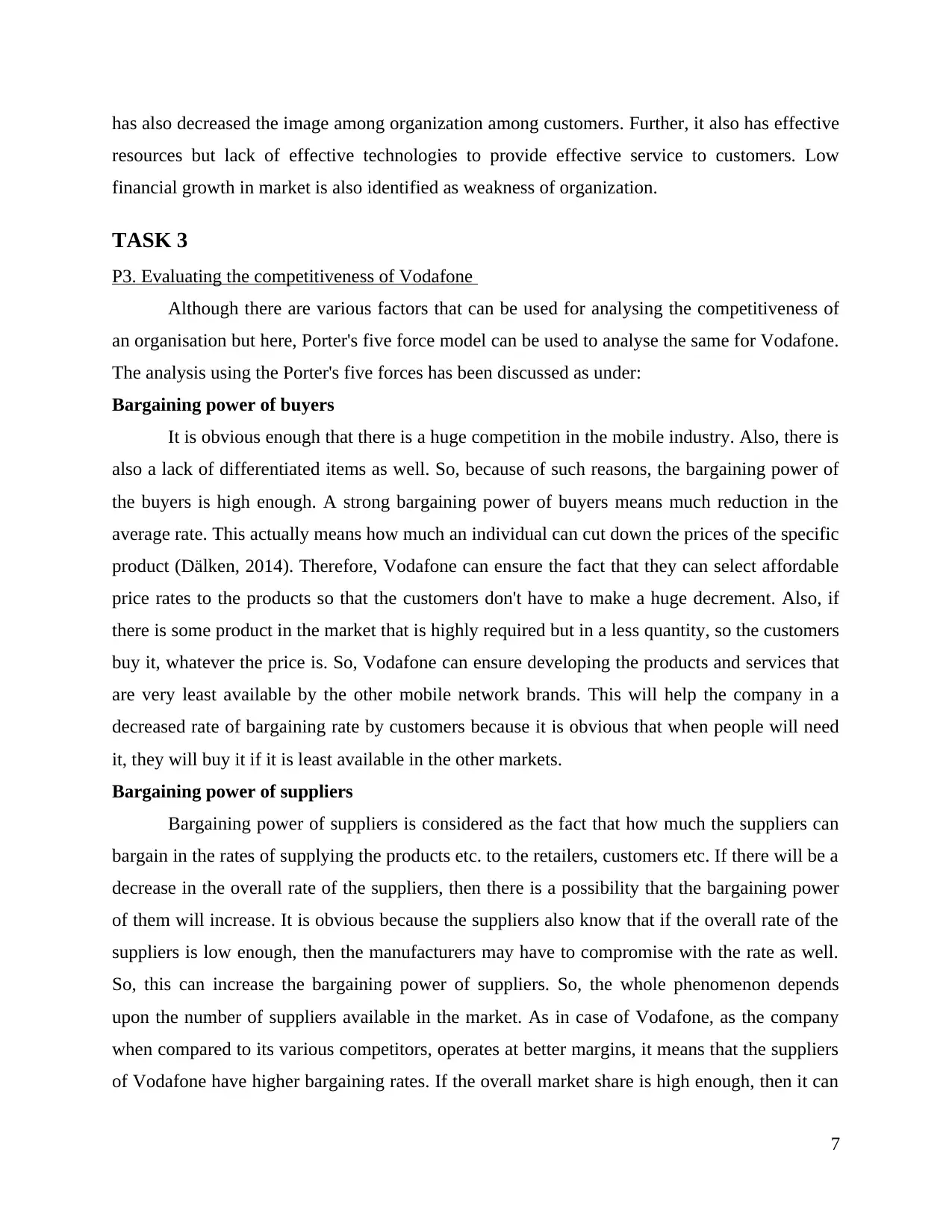
has also decreased the image among organization among customers. Further, it also has effective
resources but lack of effective technologies to provide effective service to customers. Low
financial growth in market is also identified as weakness of organization.
TASK 3
P3. Evaluating the competitiveness of Vodafone
Although there are various factors that can be used for analysing the competitiveness of
an organisation but here, Porter's five force model can be used to analyse the same for Vodafone.
The analysis using the Porter's five forces has been discussed as under:
Bargaining power of buyers
It is obvious enough that there is a huge competition in the mobile industry. Also, there is
also a lack of differentiated items as well. So, because of such reasons, the bargaining power of
the buyers is high enough. A strong bargaining power of buyers means much reduction in the
average rate. This actually means how much an individual can cut down the prices of the specific
product (Dälken, 2014). Therefore, Vodafone can ensure the fact that they can select affordable
price rates to the products so that the customers don't have to make a huge decrement. Also, if
there is some product in the market that is highly required but in a less quantity, so the customers
buy it, whatever the price is. So, Vodafone can ensure developing the products and services that
are very least available by the other mobile network brands. This will help the company in a
decreased rate of bargaining rate by customers because it is obvious that when people will need
it, they will buy it if it is least available in the other markets.
Bargaining power of suppliers
Bargaining power of suppliers is considered as the fact that how much the suppliers can
bargain in the rates of supplying the products etc. to the retailers, customers etc. If there will be a
decrease in the overall rate of the suppliers, then there is a possibility that the bargaining power
of them will increase. It is obvious because the suppliers also know that if the overall rate of the
suppliers is low enough, then the manufacturers may have to compromise with the rate as well.
So, this can increase the bargaining power of suppliers. So, the whole phenomenon depends
upon the number of suppliers available in the market. As in case of Vodafone, as the company
when compared to its various competitors, operates at better margins, it means that the suppliers
of Vodafone have higher bargaining rates. If the overall market share is high enough, then it can
7
resources but lack of effective technologies to provide effective service to customers. Low
financial growth in market is also identified as weakness of organization.
TASK 3
P3. Evaluating the competitiveness of Vodafone
Although there are various factors that can be used for analysing the competitiveness of
an organisation but here, Porter's five force model can be used to analyse the same for Vodafone.
The analysis using the Porter's five forces has been discussed as under:
Bargaining power of buyers
It is obvious enough that there is a huge competition in the mobile industry. Also, there is
also a lack of differentiated items as well. So, because of such reasons, the bargaining power of
the buyers is high enough. A strong bargaining power of buyers means much reduction in the
average rate. This actually means how much an individual can cut down the prices of the specific
product (Dälken, 2014). Therefore, Vodafone can ensure the fact that they can select affordable
price rates to the products so that the customers don't have to make a huge decrement. Also, if
there is some product in the market that is highly required but in a less quantity, so the customers
buy it, whatever the price is. So, Vodafone can ensure developing the products and services that
are very least available by the other mobile network brands. This will help the company in a
decreased rate of bargaining rate by customers because it is obvious that when people will need
it, they will buy it if it is least available in the other markets.
Bargaining power of suppliers
Bargaining power of suppliers is considered as the fact that how much the suppliers can
bargain in the rates of supplying the products etc. to the retailers, customers etc. If there will be a
decrease in the overall rate of the suppliers, then there is a possibility that the bargaining power
of them will increase. It is obvious because the suppliers also know that if the overall rate of the
suppliers is low enough, then the manufacturers may have to compromise with the rate as well.
So, this can increase the bargaining power of suppliers. So, the whole phenomenon depends
upon the number of suppliers available in the market. As in case of Vodafone, as the company
when compared to its various competitors, operates at better margins, it means that the suppliers
of Vodafone have higher bargaining rates. If the overall market share is high enough, then it can
7
⊘ This is a preview!⊘
Do you want full access?
Subscribe today to unlock all pages.

Trusted by 1+ million students worldwide
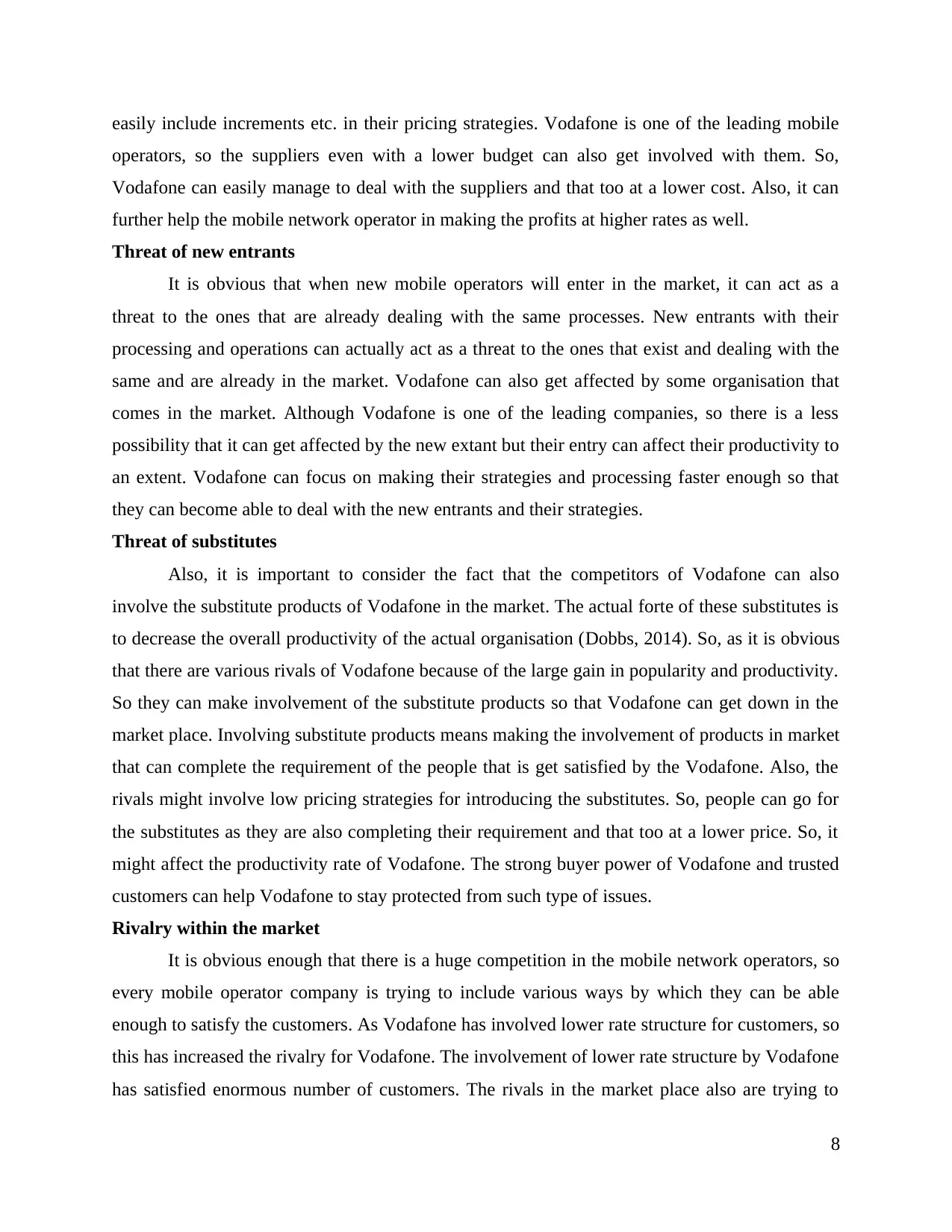
easily include increments etc. in their pricing strategies. Vodafone is one of the leading mobile
operators, so the suppliers even with a lower budget can also get involved with them. So,
Vodafone can easily manage to deal with the suppliers and that too at a lower cost. Also, it can
further help the mobile network operator in making the profits at higher rates as well.
Threat of new entrants
It is obvious that when new mobile operators will enter in the market, it can act as a
threat to the ones that are already dealing with the same processes. New entrants with their
processing and operations can actually act as a threat to the ones that exist and dealing with the
same and are already in the market. Vodafone can also get affected by some organisation that
comes in the market. Although Vodafone is one of the leading companies, so there is a less
possibility that it can get affected by the new extant but their entry can affect their productivity to
an extent. Vodafone can focus on making their strategies and processing faster enough so that
they can become able to deal with the new entrants and their strategies.
Threat of substitutes
Also, it is important to consider the fact that the competitors of Vodafone can also
involve the substitute products of Vodafone in the market. The actual forte of these substitutes is
to decrease the overall productivity of the actual organisation (Dobbs, 2014). So, as it is obvious
that there are various rivals of Vodafone because of the large gain in popularity and productivity.
So they can make involvement of the substitute products so that Vodafone can get down in the
market place. Involving substitute products means making the involvement of products in market
that can complete the requirement of the people that is get satisfied by the Vodafone. Also, the
rivals might involve low pricing strategies for introducing the substitutes. So, people can go for
the substitutes as they are also completing their requirement and that too at a lower price. So, it
might affect the productivity rate of Vodafone. The strong buyer power of Vodafone and trusted
customers can help Vodafone to stay protected from such type of issues.
Rivalry within the market
It is obvious enough that there is a huge competition in the mobile network operators, so
every mobile operator company is trying to include various ways by which they can be able
enough to satisfy the customers. As Vodafone has involved lower rate structure for customers, so
this has increased the rivalry for Vodafone. The involvement of lower rate structure by Vodafone
has satisfied enormous number of customers. The rivals in the market place also are trying to
8
operators, so the suppliers even with a lower budget can also get involved with them. So,
Vodafone can easily manage to deal with the suppliers and that too at a lower cost. Also, it can
further help the mobile network operator in making the profits at higher rates as well.
Threat of new entrants
It is obvious that when new mobile operators will enter in the market, it can act as a
threat to the ones that are already dealing with the same processes. New entrants with their
processing and operations can actually act as a threat to the ones that exist and dealing with the
same and are already in the market. Vodafone can also get affected by some organisation that
comes in the market. Although Vodafone is one of the leading companies, so there is a less
possibility that it can get affected by the new extant but their entry can affect their productivity to
an extent. Vodafone can focus on making their strategies and processing faster enough so that
they can become able to deal with the new entrants and their strategies.
Threat of substitutes
Also, it is important to consider the fact that the competitors of Vodafone can also
involve the substitute products of Vodafone in the market. The actual forte of these substitutes is
to decrease the overall productivity of the actual organisation (Dobbs, 2014). So, as it is obvious
that there are various rivals of Vodafone because of the large gain in popularity and productivity.
So they can make involvement of the substitute products so that Vodafone can get down in the
market place. Involving substitute products means making the involvement of products in market
that can complete the requirement of the people that is get satisfied by the Vodafone. Also, the
rivals might involve low pricing strategies for introducing the substitutes. So, people can go for
the substitutes as they are also completing their requirement and that too at a lower price. So, it
might affect the productivity rate of Vodafone. The strong buyer power of Vodafone and trusted
customers can help Vodafone to stay protected from such type of issues.
Rivalry within the market
It is obvious enough that there is a huge competition in the mobile network operators, so
every mobile operator company is trying to include various ways by which they can be able
enough to satisfy the customers. As Vodafone has involved lower rate structure for customers, so
this has increased the rivalry for Vodafone. The involvement of lower rate structure by Vodafone
has satisfied enormous number of customers. The rivals in the market place also are trying to
8
Paraphrase This Document
Need a fresh take? Get an instant paraphrase of this document with our AI Paraphraser
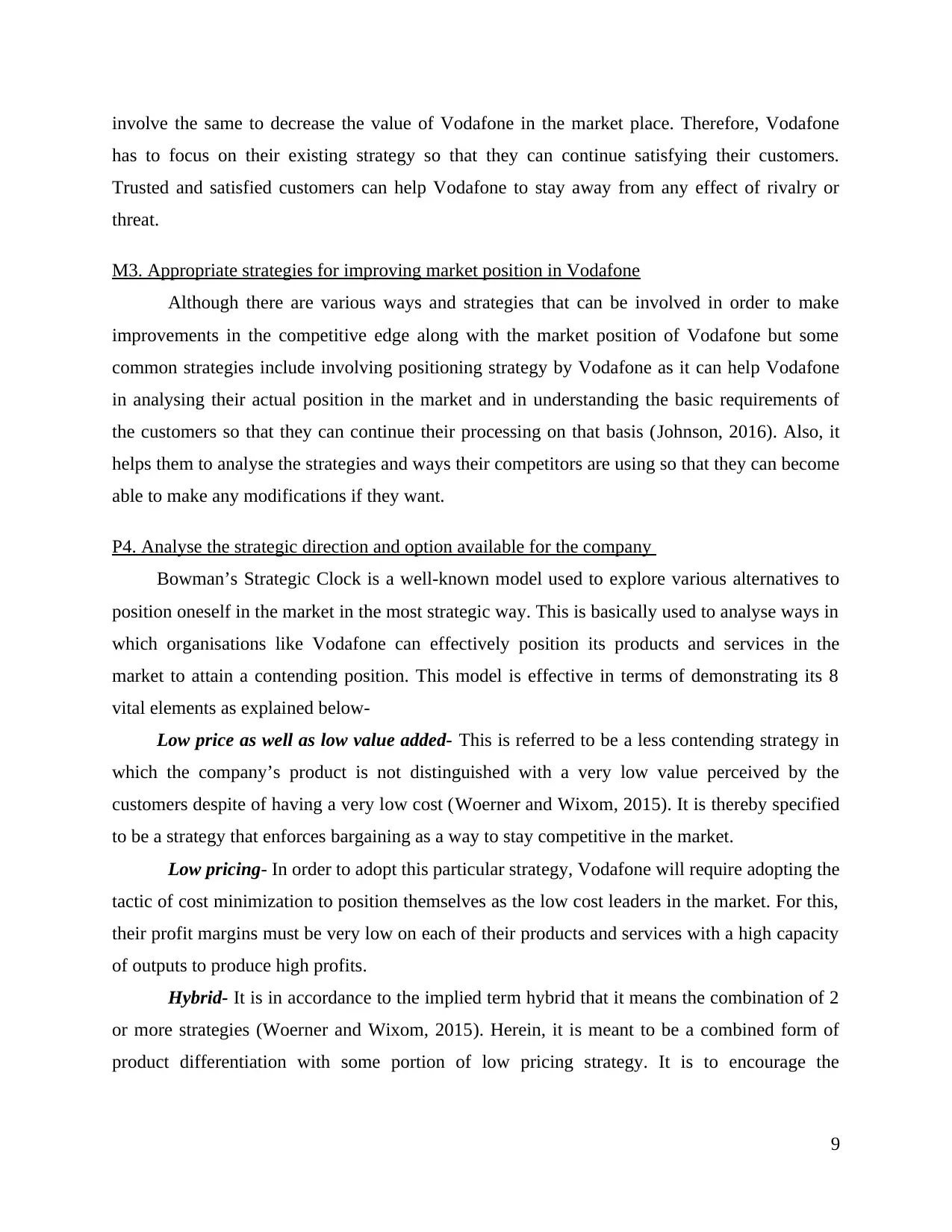
involve the same to decrease the value of Vodafone in the market place. Therefore, Vodafone
has to focus on their existing strategy so that they can continue satisfying their customers.
Trusted and satisfied customers can help Vodafone to stay away from any effect of rivalry or
threat.
M3. Appropriate strategies for improving market position in Vodafone
Although there are various ways and strategies that can be involved in order to make
improvements in the competitive edge along with the market position of Vodafone but some
common strategies include involving positioning strategy by Vodafone as it can help Vodafone
in analysing their actual position in the market and in understanding the basic requirements of
the customers so that they can continue their processing on that basis (Johnson, 2016). Also, it
helps them to analyse the strategies and ways their competitors are using so that they can become
able to make any modifications if they want.
P4. Analyse the strategic direction and option available for the company
Bowman’s Strategic Clock is a well-known model used to explore various alternatives to
position oneself in the market in the most strategic way. This is basically used to analyse ways in
which organisations like Vodafone can effectively position its products and services in the
market to attain a contending position. This model is effective in terms of demonstrating its 8
vital elements as explained below-
Low price as well as low value added- This is referred to be a less contending strategy in
which the company’s product is not distinguished with a very low value perceived by the
customers despite of having a very low cost (Woerner and Wixom, 2015). It is thereby specified
to be a strategy that enforces bargaining as a way to stay competitive in the market.
Low pricing- In order to adopt this particular strategy, Vodafone will require adopting the
tactic of cost minimization to position themselves as the low cost leaders in the market. For this,
their profit margins must be very low on each of their products and services with a high capacity
of outputs to produce high profits.
Hybrid- It is in accordance to the implied term hybrid that it means the combination of 2
or more strategies (Woerner and Wixom, 2015). Herein, it is meant to be a combined form of
product differentiation with some portion of low pricing strategy. It is to encourage the
9
has to focus on their existing strategy so that they can continue satisfying their customers.
Trusted and satisfied customers can help Vodafone to stay away from any effect of rivalry or
threat.
M3. Appropriate strategies for improving market position in Vodafone
Although there are various ways and strategies that can be involved in order to make
improvements in the competitive edge along with the market position of Vodafone but some
common strategies include involving positioning strategy by Vodafone as it can help Vodafone
in analysing their actual position in the market and in understanding the basic requirements of
the customers so that they can continue their processing on that basis (Johnson, 2016). Also, it
helps them to analyse the strategies and ways their competitors are using so that they can become
able to make any modifications if they want.
P4. Analyse the strategic direction and option available for the company
Bowman’s Strategic Clock is a well-known model used to explore various alternatives to
position oneself in the market in the most strategic way. This is basically used to analyse ways in
which organisations like Vodafone can effectively position its products and services in the
market to attain a contending position. This model is effective in terms of demonstrating its 8
vital elements as explained below-
Low price as well as low value added- This is referred to be a less contending strategy in
which the company’s product is not distinguished with a very low value perceived by the
customers despite of having a very low cost (Woerner and Wixom, 2015). It is thereby specified
to be a strategy that enforces bargaining as a way to stay competitive in the market.
Low pricing- In order to adopt this particular strategy, Vodafone will require adopting the
tactic of cost minimization to position themselves as the low cost leaders in the market. For this,
their profit margins must be very low on each of their products and services with a high capacity
of outputs to produce high profits.
Hybrid- It is in accordance to the implied term hybrid that it means the combination of 2
or more strategies (Woerner and Wixom, 2015). Herein, it is meant to be a combined form of
product differentiation with some portion of low pricing strategy. It is to encourage the
9
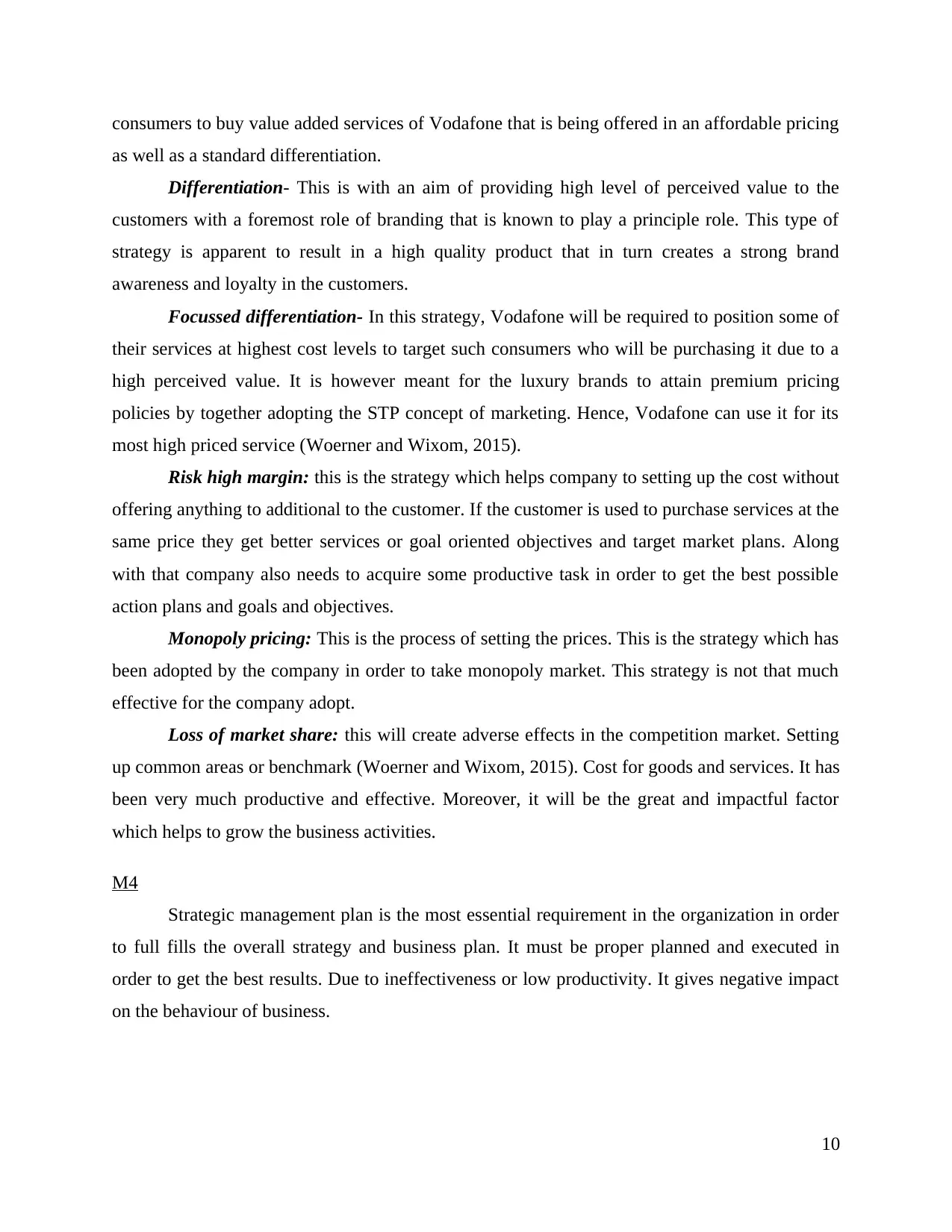
consumers to buy value added services of Vodafone that is being offered in an affordable pricing
as well as a standard differentiation.
Differentiation- This is with an aim of providing high level of perceived value to the
customers with a foremost role of branding that is known to play a principle role. This type of
strategy is apparent to result in a high quality product that in turn creates a strong brand
awareness and loyalty in the customers.
Focussed differentiation- In this strategy, Vodafone will be required to position some of
their services at highest cost levels to target such consumers who will be purchasing it due to a
high perceived value. It is however meant for the luxury brands to attain premium pricing
policies by together adopting the STP concept of marketing. Hence, Vodafone can use it for its
most high priced service (Woerner and Wixom, 2015).
Risk high margin: this is the strategy which helps company to setting up the cost without
offering anything to additional to the customer. If the customer is used to purchase services at the
same price they get better services or goal oriented objectives and target market plans. Along
with that company also needs to acquire some productive task in order to get the best possible
action plans and goals and objectives.
Monopoly pricing: This is the process of setting the prices. This is the strategy which has
been adopted by the company in order to take monopoly market. This strategy is not that much
effective for the company adopt.
Loss of market share: this will create adverse effects in the competition market. Setting
up common areas or benchmark (Woerner and Wixom, 2015). Cost for goods and services. It has
been very much productive and effective. Moreover, it will be the great and impactful factor
which helps to grow the business activities.
M4
Strategic management plan is the most essential requirement in the organization in order
to full fills the overall strategy and business plan. It must be proper planned and executed in
order to get the best results. Due to ineffectiveness or low productivity. It gives negative impact
on the behaviour of business.
10
as well as a standard differentiation.
Differentiation- This is with an aim of providing high level of perceived value to the
customers with a foremost role of branding that is known to play a principle role. This type of
strategy is apparent to result in a high quality product that in turn creates a strong brand
awareness and loyalty in the customers.
Focussed differentiation- In this strategy, Vodafone will be required to position some of
their services at highest cost levels to target such consumers who will be purchasing it due to a
high perceived value. It is however meant for the luxury brands to attain premium pricing
policies by together adopting the STP concept of marketing. Hence, Vodafone can use it for its
most high priced service (Woerner and Wixom, 2015).
Risk high margin: this is the strategy which helps company to setting up the cost without
offering anything to additional to the customer. If the customer is used to purchase services at the
same price they get better services or goal oriented objectives and target market plans. Along
with that company also needs to acquire some productive task in order to get the best possible
action plans and goals and objectives.
Monopoly pricing: This is the process of setting the prices. This is the strategy which has
been adopted by the company in order to take monopoly market. This strategy is not that much
effective for the company adopt.
Loss of market share: this will create adverse effects in the competition market. Setting
up common areas or benchmark (Woerner and Wixom, 2015). Cost for goods and services. It has
been very much productive and effective. Moreover, it will be the great and impactful factor
which helps to grow the business activities.
M4
Strategic management plan is the most essential requirement in the organization in order
to full fills the overall strategy and business plan. It must be proper planned and executed in
order to get the best results. Due to ineffectiveness or low productivity. It gives negative impact
on the behaviour of business.
10
⊘ This is a preview!⊘
Do you want full access?
Subscribe today to unlock all pages.

Trusted by 1+ million students worldwide
1 out of 14
Related Documents
Your All-in-One AI-Powered Toolkit for Academic Success.
+13062052269
info@desklib.com
Available 24*7 on WhatsApp / Email
![[object Object]](/_next/static/media/star-bottom.7253800d.svg)
Unlock your academic potential
Copyright © 2020–2025 A2Z Services. All Rights Reserved. Developed and managed by ZUCOL.





